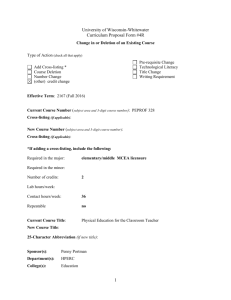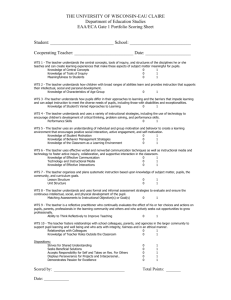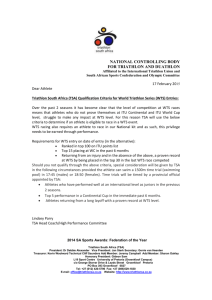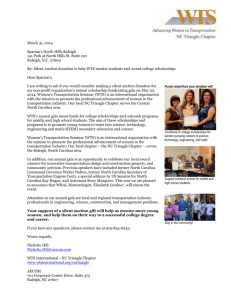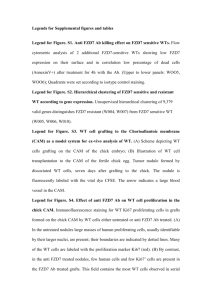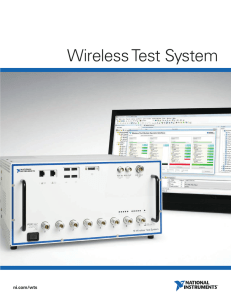PEPROF 328 Physical Education for the Classroom Teacher
advertisement
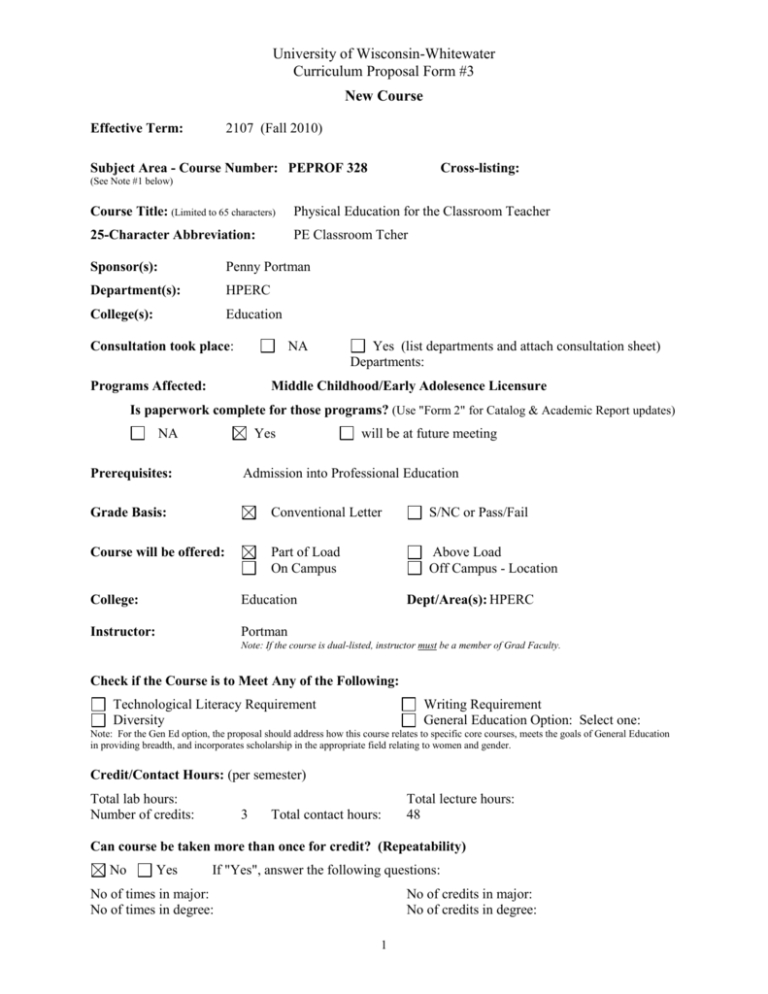
University of Wisconsin-Whitewater Curriculum Proposal Form #3 New Course Effective Term: 2107 (Fall 2010) Subject Area - Course Number: PEPROF 328 Cross-listing: (See Note #1 below) Course Title: (Limited to 65 characters) Physical Education for the Classroom Teacher 25-Character Abbreviation: PE Classroom Tcher Sponsor(s): Penny Portman Department(s): HPERC College(s): Education Consultation took place: NA Programs Affected: Yes (list departments and attach consultation sheet) Departments: Middle Childhood/Early Adolesence Licensure Is paperwork complete for those programs? (Use "Form 2" for Catalog & Academic Report updates) NA Yes Prerequisites: will be at future meeting Admission into Professional Education Grade Basis: Conventional Letter S/NC or Pass/Fail Course will be offered: Part of Load On Campus Above Load Off Campus - Location College: Education Instructor: Portman Dept/Area(s): HPERC Note: If the course is dual-listed, instructor must be a member of Grad Faculty. Check if the Course is to Meet Any of the Following: Technological Literacy Requirement Diversity Writing Requirement General Education Option: Select one: Note: For the Gen Ed option, the proposal should address how this course relates to specific core courses, meets the goals of General Education in providing breadth, and incorporates scholarship in the appropriate field relating to women and gender. Credit/Contact Hours: (per semester) Total lab hours: Number of credits: 3 Total contact hours: Total lecture hours: 48 Can course be taken more than once for credit? (Repeatability) No Yes If "Yes", answer the following questions: No of times in major: No of times in degree: No of credits in major: No of credits in degree: 1 Proposal Information: (Procedures for form #3) Course justification: The Department of Public Instruction created new licensure delineations for elementary/middle classroom preservice teachers. This course is designed to meet the needs of middle childhood/early adolescence licensure students and replaces both Physical Education for the Kindergarten-Third Classroom Teacher (PEPROF 325) and Physical Education for the 4th-8th Classroom Teacher (PEPROF 326). Relationship to program assessment objectives: This new course will align itself with the Department of Public Instruction’s licensure delineations. Budgetary impact: HPRC Department will adjust internally to meet any impact Course description: (50 word limit) This course is designed for those who plan to work with children middle childhood/early adolescence. Emphasis will be placed on understanding, planning, and teaching a developmentally appropriate and integrative physical activity for children within these ages. If dual listed, list graduate level requirements for the following: 1. Content (e.g., What are additional presentation/project requirements?) 2. Intensity (e.g., How are the processes and standards of evaluation different for graduates and undergraduates? ) 3. Self-Directed (e.g., How are research expectations differ for graduates and undergraduates?) Course objectives and tentative course syllabus: See attached Bibliography: (Key or essential references only. Normally the bibliography should be no more than one or two pages in length.) * = in Library *Carlson, T & Gorley, T. (2004). Moving Metaphors for Teachers and Coaches. Strategies. September/October. Center for Science in Public Interest. (2004) Ten Super Foods You Should Eat. Nutrition Action Newsletter. *NASPE. (1995). Content Standards in Physical Education. *Couturier, L., Chepko, S., & Coughlin, MA. (2005). Student Voices-What Middle and High School Students Have to Say about Physical Education. The Physical Educator. 170-175. *Elliott, S. (2003) Creating Interdisciplinary Lessons in Elementary Physical Educaiton. Strategies. July/August. 19-22. *Erwin, H. & Bachtel. (2007). TAG (Teaching Active Games) for the Holidays. Strategies. November/December. 21-24 *Jones, K. & Block, M. (2006) Including an Austistic Middle School Child in General Physical Education. Strategies. March/April. 13-16. *Rahnke, K. (2005) Silver Bullets. Project Adventure. *Rink, J. (1999). Baseball Theory of Teacher Effectiveness. Washington Association of Health, Physical Education, Recreation and Coaching. 2 *Schwager, S. (1992). Relay Races-Are they appropriate for elementary physical education? Journal of Health, Physical Education, Recreation and Dance. P. 54-57. Strecker, L. (2007). Protect Yourself and Others: Avoid Liability in Physical Activity Settings. Update Plus. American Alliance for Health, Physical Education, Recreation and Dance. 28-30. *Stevens-Smith, D. & Fones, S. (2002) Scootin’ with Newton: Teaching Newton’s Second Law Using Motion. Strategies. November/December. 7-10. Stran, M. & Hardin, B. (2002). Teaching Dance to Children with Ambulatory Disabilities. Teaching Elementary Physical Education. September. 129-132. *Temple, V. (2003). Warm-up to Lacrosse. Strategies. March/April. *Tummers, N. (2005). Yoga for Your Student. Strategies. November/December. 35-38. *Williams, N. (1992) The Physical Education Hall of Shame. Journal of Health, Physical Education, Recreation and Dance. p. 39-41. Notes: 1. Contact the Registrar's Office (x1570) for available course numbers. See Subject Areas listing (on page 14) 2. The 15 and 25 character abbreviations may be edited for consistency and clarity. 3. Please submit electronically when approved at the college level - signature sheet to follow in hard copy. Physical Education for the Classroom Teacher (middle childhood/early adolescence) Instructor: Dr. Penny Portman 114 Williams Center 472-5643 portmanp@uww.edu Office Hours: TTH 11:30-2:00 Pre-requisites: Must be admitted into the College of Education Textbook: Physical Education for Classroom Teachers (packet available on main floor of Textbook Center). Course Description: This course is designed for those who plan to work with children in 4th through 8th grades. Emphasis will be placed on understanding, planning, and teaching a developmental physical activity program appropriate for these children. Objectives: By the end of the course: 1. The student understands physical education content, interdisciplinary concepts, disciplinary concepts, and tools of inquiry related to the development of a physically educated person. (WTS #1) Specifically the student will receive specific instruction, activities and assignments on appropriate physical education for students 4th through 8th grades, notably classroom rules and discipline procedures, interdisciplinary curricular approaches in cooperative activities, health, science, math, social studies, and language arts with physical activity, and assessment tools. Assessment: Reflective Activity Paper 3 2. The student understands how children learn and develop and can provide learning opportunities that support that intellectual, social, and personal development. (WTS #2) Specifically the student will observe physical education classes and develop an ageappropriate interdisciplinary lesson plan to be taught first to peers and then to the classroom students. Assessment: Toy/TV Assignment 3. The student uses an understanding of individual and group motivation and instructional strategies to create a learning environment that encourages positive social interaction, active learning, and self motivation. (WTS #3) Specifically the student will discuss, observe the use of by a master teacher, and utilize the strategies in their classroom lesson to their peers and in-school students. Assessment: Observations in physical education setting 4. The student demonstrates an understanding of teaching strategies designed to increase student time on task and individualize instruction to accommodate a variety of skill levels. (WTS # 4, 5, 7) Specifically the student will practice management skills in small group situations among their peers and utilize the teaching strategies in their lessons. Assessment: Classroom Rules and Peer-Teaching on Management 5. The student plans instruction and uses formal and informal reflection strategies based upon knowledge of the subject matter, students, the community, and curriculum goals (WTS #9). Specifically the student will plan, teach, and evaluate two developmentally appropriate interdisciplinary physical activity lessons. Assessment: Lesson Plans and Evaluation of Lessons 6. The student understands how students differ in their approaches to learning and understands how federal laws (IDEA, Title IX, Negligence/Liability) affect physical education programs. (WTS #10) Specifically the student will apply knowledge of safe environments in their teaching. Assessment: Simulation Exercise All assignments will be handed in on time unless previous arrangements have been made. Late assignments will not be accepted. Teaching can only be re-scheduled if arrangements are made prior to day of teaching. . 4 Grading: Your grade will be based on the total number of points accumulated during the semester. Points will be given for the following: Reflective Activity Paper (1) 50 point = 50 points Lesson plan (2) peer/on-site 10 points each = 20 Teaching experience (2) peer/on-site 20 points each = 40 Evaluation of one’s lesson (2) peer/on-site 10 points each = 20 Observations (2) 10 points each = 20 TV/Toys = 15 Rules = 10 Pedometer Exercise = 15 Discretionary = 10 Total A = 93-100% A- 90-92 B+ 87-89 B 83-86 B- 80-82 = 200 C+ = 77-79 C 73-76 C70-72 D+ 67-69 D 63-66 D- = 60-62 F 59 or below UW-W has a no cut policy. All students may miss 2 classes without penalty. All other classes missed will result in a 10 (ten) point deduction per class missed. Two tardies will drop 5 points from your total points. Attendance will be taken at every class. Students will be excused from class of religious observances (and all school sponsored events) if notification is given within the first two weeks of school. It is the student’s responsibility to make up all work and turn in assignments on time. The University of Wisconsin-Whitewater is dedicated to a safe, supportive, and non-discriminatory learning environment. It is the responsibility of all undergraduate and graduate students to familiarize themselves with University policies regarding Special Accommodations, Academic Misconduct, Religious Beliefs Accommodation, Discrimination and Absence for University Sponsored Events. (For details please refer to the Schedule of Classes; the “Rights and Responsibilities” section of the Undergraduate Catalogue; the Academic Requirements and Policies and the Facilities and Services sections of the Graduate Catalogue; and the “Student Academic Disciplinary Procedures” [UWS Chapter 14]; and the “Student Nonacademic Disciplinary Procedures” [UWS Chapter 17]). “The UW System standard for work required per credit is that students are expected to invest at least 3 hours of combined in-class and out-of-class work per week for each academic unit(credit) of coursework; thus a 3-credit course will typically require a minimum of 9 hours of work per week (144 hrs/semester).” Schedule 3 September Introduction *Survey *Toy and TV Assessment 5 8 PE Experience *Assessment-who are these students *How do I learn best? 10 Who are these students? *Baseball Theory of Teaching Effectiveness (packet) 15 How do good teachers teach? Management Strategies-video *Rules Assessment 17 Management Scenarios *Rules Due 22 Teaching Booklet (packet) 24 What do good teacher teach? *Integrating curriculum in packet *Reflective paper assignment 29 Integrating Physical Activity across the Curriculum The Environment/Science 1 Oct Integrating Physical Activity- Health Life Style *Favorite snacks 6 Integrating Physical Activity- Social Studies/Language Arts *Baseball Theory- 2nd base 8 How do good teachers teach? Lesson Plan formats Title IX Reflective Paper Due *Cooperative section in packet 13 Teaching Cooperation using movement 15 Increasing self-esteem through problem solving 20 Lesson Planning 22 Negligence and Liability *packet and Lesson Plans for 1 & 2 27 Group 1 – Inclass teaching *Lesson Plans due for groups 3 & 4 29 Group 2 – Inclass teaching *Lesson Plans due for groups 5 & 6 3 November Group 3 – Inclass Teaching 5 Group 4-Inclass teaching 10 Group 5-Inclass Teaching 12 Group 6-Inclass Teaching *read packet on fitness 17 Wellness and Healthy Lifestyle 19 Wellness and Healthy Lifestyle 24 School Observations 30 Working with children with disabilities 1 December Wheelchair Basketball Team Demonstration 3 Field trip to Lakeland School ??? 8 Wrap up 10 Final evaluations Final – Tuesday 16 December 9:00 6
